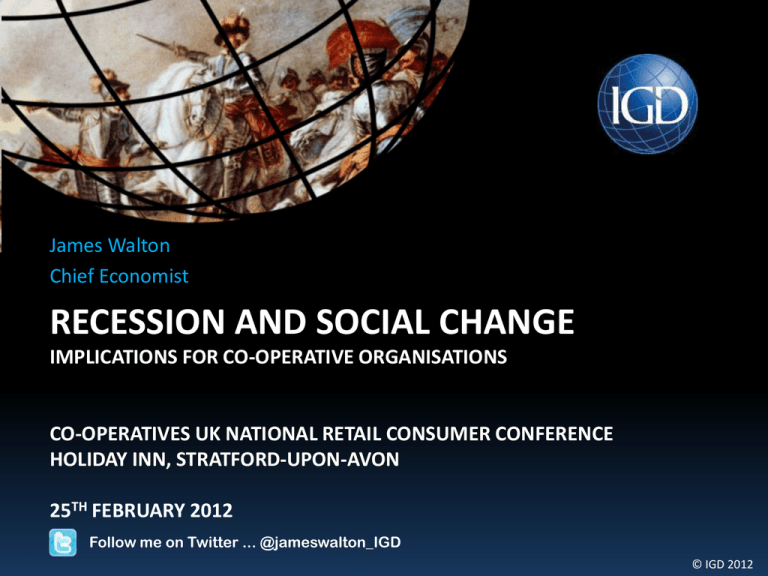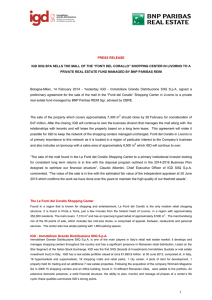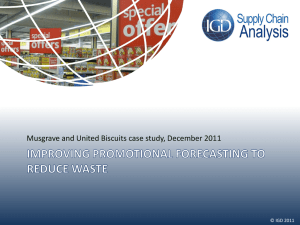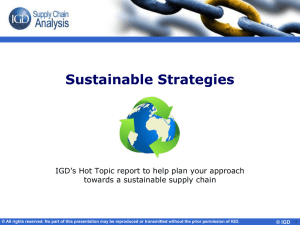
James Walton
Chief Economist
RECESSION AND SOCIAL CHANGE
IMPLICATIONS FOR CO-OPERATIVE ORGANISATIONS
CO-OPERATIVES UK NATIONAL RETAIL CONSUMER CONFERENCE
HOLIDAY INN, STRATFORD-UPON-AVON
25TH FEBRUARY 2012
Follow me on Twitter ... @jameswalton_IGD
© IGD 2012
The Heart Of England
We are here
© IGD 2012
Edge Hill, 23rd October 1642
Image: www.thinkstockphotos.com, February 2011
© IGD 2012
Depression And War – Some Long Term Legacies
New global
institutions
Universal view of
human rights
Modern
feminism
Socialised
healthcare
Images: www.thinkstockphotos.com, February 2011
© IGD 2012
Euro Area Sovereign Debt
180
Government debt vs GDP (%)
160
140
120
100
80
SGP legal limit
on
government
debt
60
40
20
0
Source: Table 78, Statistical Annex Of European Economy (November 2011), EU Commission
Data is EU Commission estimates for full year 2011
© IGD 2012
Where The Money Goes
80
Total govt spending vs GDP (%)
70
60
50
40
30
20
10
0
Paternal functions
Maternal functions
Other functions
Source: Eurostat / IGD Research, February 2012 (data is for 2009, latest consistent data available)
“Paternal” functions are: defence and protection
“Maternal” functions are: education, health, pensions and welfare
© IGD 2012
What Next?
If a Euro Area member defaults on sovereign debt:
• Banks that have supported that member lose their shirts
• Lenders panic, “contagion” spreads across the world
• Business is paralysed, confidence plummets
• Nations that have contributed to bailouts lose money
• Stored “paper” wealth is annihilated on a vast scale
• New Credit Crunch for governments and businesses, as lenders flee from risk
• Social unrest as wages and benefits go unpaid
• Inflation, as QE is used to erode the value of debt
• The value of the Euro crashes
• Rampaging trolls descend from hills
• Recession – a really bad one this time
If disaster is averted:
• Same, only less so (ie: fewer trolls, with smaller clubs)
© IGD 2012
A Phenomenal Personal Record
Debt issued by first 43
presidents:
US$10.6 trillion (in 220
years)
Debt issued by 44th
president :
US$4.7 trillion (in 3
years)
Source: US Treasury, February 2012
Images: www.thinkstockphotos.com, February 2012
© IGD 2012
Global Commodity Price Trends
600
Volatility indicates supply
shortfalls across multiple
items
Global price index (Jan 00 = 100)
Slight falls in price in late 2011
reflect weakening demand in
major economies
500
400
300
200
100
As costs rise, so the cost of waste goes
up – processing, packaging and
logistics become more critical
0
Industrial
materials
Energy
Jan-00 Jan-01 Jan-02 Jan-03 Jan-04 Food
Jan-05 Jan-06
Jan-07 Jan-08
Jan-09 Jan-10
Jan-11
Source: IMF, February 2012
Indices rebased by IGD
© IGD 2012
Implications 1
1. The future remains extremely uncertain
a. Businesses must stay alert – is your information good enough?
b. Plans must remain flexible – how often do you review yours?
c. Speedy decision making is vital – how fast are your procedures?
2. The banking sector is exposed to serious sovereign debt risk (therefore we all are)
a. Do not expect the credit situation to ease – it may worsen
b. Capital will remain scarce – luckily, grocery businesses are often cash rich
c. Expect businesses to hoard cash – payment terms will be hotly contested
3. Currency / commodity values may fluctuate wildly
a. Hedging may protect businesses from price volatility
b. Currency change may create unexpected trading / acquisition opportunities
c. Watch the situation in the Persian Gulf carefully
© IGD 2012
UK GDP Performance
Recovery has been weak
and patchy
Danger of a double dip has
risen in the last week
6
4
Q1 2011
Q1 2010
Q1 2009
Q1 2008
Q1 2007
Q1 2006
Q1 2005
Q1 2004
Q1 2003
Q1 2002
Q1 2001
0
Q1 2000
UK real GDP growth (%)
2
-2
-4
-6
Revised data shows that UK
recession was more severe
than initially thought, but
growth in run-up to
recession was stronger
GDP growth: q on previous q (ihyq)
-8
Source: ONS, February 2012
GDP growth: q on same q previous year (ihyr)
Data is seasonally adjusted
Letter codes refer to specific ONS measures, dotted line shows November OBR forecast
© IGD 2012
Household Spending – Top Level
UK household spending index (Q1 2000 = 100)
180
Gaps show permanent
impact of recession on
demand
170
160
150
140
130
Even before the recession,
inflation was driving market
growth
120
110
In volume terms, household
spending is still below prerecession levels
100
90
80
Q1 2000 Q1 2001 Q1 2002 Q1 2003 Q1 2004 Q1 2005 Q1 2006 Q1 2007 Q1 2008 Q1 2009 Q1 2010 Q1 2011
At current prices
Trend, at current prices
Source: ONS / IGD Research, February 2012
Data is based on ONS measure abjq, adjusted using an estimated GDP deflator
Trend is continuation of average q-on-q growth rate for Q1 2000 to Q4 2007
© IGD 2012
Household Spending – Per Capita
UK household spending index (Q1 2000 = 100)
180
170
160
150
140
130
120
110
100
“True” demand is roughly
2006 level
90
80
Q1 2000 Q1 2001 Q1 2002 Q1 2003 Q1 2004 Q1 2005 Q1 2006 Q1 2007 Q1 2008 Q1 2009 Q1 2010 Q1 2011
At current prices
Trend, at current prices
Source: ONS / IGD Research, February 2012
Data is based on ONS measure abjq, adjusted using an estimated GDP deflator
Trend is continuation of average q-on-q growth rate for Q2 2000 to Q4 2007, per capita data based on population measure dyay
© IGD 2012
Volume Demand
Volume grocery retail sales (index, Jan 2000 = 100)
130
125
120
115
110
105
There has been no real
volume growth in European
grocery since 2008
100
This is in spite of population
growth of +1% (EU) and
+2% (UK) over the same
period
95
90
Jan-00
Jan-01
Jan-02
Jan-03
Jan-04
Jan-05
Jan-06
EU27, grocery
Jan-07
Jan-08
Jan-09
Jan-10
Jan-11
UK, grocery
Source: Short Term Business Statistics and Population & Social Conditions, Eurostat, February 2012
Shows measure tovv for g47_food, data is seasonally adjusted, indices rebased by IGD
© IGD 2012
2,700
UK average at-home energy
consumption has fallen 5% in 10
years
350
2,500
UK average out-of-home
consumption has fallen by 15%
over the same time
300
2,300
250
2,100
200
Dept of Health aims to reduce
consumption by a further 100 cals /
person / day
1,900
150
Av UK out-of-home calorific intake (cals / person / day)
Av UK at-home calorific intake (cals / person / day)
Trends In Nutrition
100
At-home, lhs
2010
2008
2006
2004-05
2002-03
2000
1998
1996
1994
1992
1990
1988
1986
1984
1982
1980
1978
1976
1974
1,700
Out-of-home, rhs
Source: Family Food 2010, DEFRA, December 2011 (latest data available)
Limited historical data is available for out-of-home consumption
© IGD 2012
Shopper Mood Is At An All-Time Low
Consumer confidence index (May 2004=100)
140
Initially, shoppers expected a quick
recovery from recession
Later on, expectations were revised
downwards
120
100
80
60
40
20
Present situation
Nov-11
May-11
Nov-10
May-10
Nov-09
May-09
Nov-08
May-08
Nov-07
May-07
Nov-06
May-06
Nov-05
May-05
Nov-04
May-04
0
Future expectations
Source: Nationwide, February 2012
Base: 1,000 UK respondents, balanced sample
Indices show consumer confidence compared with May 2004, the base period – data is seasonally adjusted
© IGD 2012
Shoppers Expect To Be Poorer In Future
Personal economic expectations over next 12 months
Some signs of an
improvement in
sentiment in recent
months
Do shoppers think that
things are as bad as they
can get?
Source: ShopperVista, IGD, February 2012
Base: 1,000 UK main shoppers per month, balanced sample
© IGD 2012
Growth In Real Wealth Is At A Standstill
Av annual change 1980-2000: + 3.0%
Av annual change 2001-2010: + 1.9%
Av annual change 2011-2016: + 0.6%
Source: ONS, February 2012
Shows annual change in household disposable income, adjusted for the effect of taxes, benefits and inflation
Data for 2011 onwards is OBR estimates
© IGD 2012
Implications 2
4. A return to recession is still possible
a. Businesses may wish to maintain a defensive posture
b. Shoppers are also likely to stay cautious, unwilling to expose themselves
5. Volume sales for many businesses – including grocery – have been sluggish for years
a. Achieving scale economies may be difficult – can process innovation help?
b. In a static market, growth means taking share – expect savage competition
c. Still, compared with other businesses, grocery still looks like a good bet!
6. Weak retail performance may impact the value of commercial property
a. Far-sighted retailers may snap up sites with a view to eventual retail recovery
b. Independents planning to exit the market may be affected by low prices
c. Will town centre sites suffer if shoppers shop less?
© IGD 2012
The Growth Of The Maternal State
80
Total UK govt spending vs GDP (%)
70
Current austerity plan is
controversial, but modest
60
50
40
30
20
10
Paternal functions
Maternal functions
2010
2000
1990
1980
1970
1960
1950
1940
1930
1920
1910
1900
1890
1880
1870
1860
1850
1840
1830
1820
1810
1800
0
Other functions
Source: www.ukpublicspending.co.uk / IGD Research, February 2012
“Paternal” functions are: defence and protection
“Maternal” functions are: education, health, pensions and welfare
© IGD 2012
The Scale Of Austerity – Top Level
Total managed govt exp (£bn, 2010-11 values)
900
800
700
600
500
The austerity currently envisaged is
far short of what has been seen
elsewhere in Europe but will still
mean a significant deviation from
the historical trend
400
300
Actual / forecast
2016-17
2014-15
2012-13
2010-11
2008-09
2006-07
2004-05
2002-03
2000-01
1998-99
1996-97
1994-95
1992-93
1990-91
1988-89
1986-87
1984-85
1982-83
1980-81
200
Trend 1980-2010
Source: Table 4.1, Public Expenditure Statistical Analysis and Autumn Statement 2011, HM Treasury / IGD Research, February 2012
Forecasts are based on Autumn Statement document published November 2011
Trend is based on average annual growth for 1980-2010
© IGD 2012
14,000
12,000
10,000
8,000
6,000
4,000
2,000
Actual / forecast
2016-17
2014-15
2012-13
2010-11
2008-09
2006-07
2004-05
2002-03
2000-01
1998-99
1996-97
1994-95
1992-93
1990-91
1988-89
1986-87
1984-85
1982-83
0
1980-81
Total managed govt exp (£ per head, 2010-11 values)
The Scale Of Austerity – Per Capita
Trend 1980-2010
Source: Table 4.1, Public Expenditure Statistical Analysis and Autumn Statement 2011, HM Treasury / IGD Research, February 2012
Forecasts are based on Autumn Statement document published November 2011
Trend is based on average annual growth for 1980-2010, per capita data is based on population measure dyay
© IGD 2012
Real Pain Still To Come
120
Current austerity programme will
interrupt expansion of debt, but not
for long
Public sector net debt vs GDP (%)
100
80
60
40
Debt not expected to return to prerecession levels
20
Historical data
Source: Fiscal Sustainability Report, Office For Budget Responsibility, July 2011
2060-61
2055-56
2050-51
2045-46
2040-41
2035-36
2030-31
2025-26
2020-21
2015-16
2010-11
2005-06
2000-01
1995-96
1990-91
1985-86
1980-81
1975-76
0
OBR projection
© IGD 2012
Reliance On State Support
Share of total weekly household income (%)
100
90
80
70
60
50
40
30
20
10
0
Earned income
Investments & private pensions
State pensions & disability benefits
Other benefits & tax credits
Other
Source: Table 2.1, Family Resources Survey 2009-10, Dept Of Work & Pensions, February 2012 (latest data available)
© IGD 2012
Reliance On Public Sector Employment
Public sector workers vs all workers (%)
35
30
25
20
15
10
5
0
Source: Public Sector Employment, ONS, February 2012 (data is for Q1 2011)
© IGD 2012
Impact On Families
Real change in household income, 2010 – 15 (%)
8
6
4
Most affected ...
• Households with 3 or more children
• Households with younger children
• Households in rented accommodation
• Non-white households
• Lone parents not currently in work
• Carers
2
0
All households All households w/
children
1 child
2 children
3 children
4+ children
-2
-4
-6
-8
Source: The Impact Of Austerity Measures On Households With Children, IFS and FPI, January 2012
© IGD 2012
Economic / Social Variation By Neighbourhood
The Swan
W’hampstead
AL4
National
average
The Swan
M’chester
M40
Domestic burglary
7.4
9.6
17.2
Sex crime
0.4
1.0
1.7
Vehicle crime
6.3
8.2
13.8
Violent crime
7.5
14.8
22.3
GCSE pass rate
84%
51%
38%
Av gross weekly earnings, FT
£525
£500
£439
Economic inactivity rate
23%
24%
32%
Soc 2000 major group 1-3
65%
45%
44%
Soc 2000 major group 8-9
9%
18%
14%
80.9
77.9
75.9
21.1%
20.0%
25.1%
Measure
Social
Work
Life exp at birth, male
Health
Binge drinking
Sources: Local Alcohol Profiles For England / Nomis / ONS / UpMyStreet , February 2012
Crime rates show offences per 1,000 / year, for 2010-11
GCSE results show share of pupils attaining 5 or more A*- C grades, for nearest state secondary school for 2010
Employment data is for 2010, prevalence of binge drinking is estimate for 2007-08 from LAPE
© IGD 2012
Ink Blot Protests
Images: Private collection, all taken at St Paul’s, London, November 2011
© IGD 2012
Public Health Responsibility Deal
• Launched March 2011
• Businesses and other organisations are invited to sign up to pledges
• There are 19 pledges, covering:
• Alcohol (7)
• Food (3)
• Health at work (4)
• Physical activity (5)
• Pledges are made public via Dept of Health website
• Businesses are expected to report on progress
• 273 companies signed up in the first six months (including co-ops)
• New pledge under discussion – reduce food consumption by 100 cals / person / day
© IGD 2012
Implications 3
7. Poor economic performance may lead government to adjust its tax / spending plans
a. The impact of austerity will vary widely by location, age, job etc
b. Businesses will need to be sensitive to these variations
c. Even if plans stay the same, austerity will create revolutionary change
d. Austerity impacts will aggravate existing harms caused by recession
8. Social / economic / political change will influence how people interact with businesses
a. Any business not creating clear social benefits may be seen as “fair game”
b. Small businesses cannot survive unscathed if the host community weakens
c. Some products (eg: BWS, sugar) may be targeted for special tax increases
d. Plan for further legal intervention in marketing, advertising etc
e. Plan for further reductions in food volumes
© IGD 2012
Inflation May Have Peaked
VAT increases begin to
annualise from Jan 2012
6
Est contribution to CPI (%)
5
4
3
2
1
Food and non-alc drinks (d7g8)
Alc drinks and tob (d7g9)
Restaurants and hotels (d7gi)
Housing, utilities (d7gb)
Transport (d7ge)
Other items (7 fields)
Nov-11
Aug-11
May-11
Feb-11
Nov-10
Aug-10
Feb-10
Nov-09
Aug-09
May-10
-1
May-09
Feb-09
0
Source: ONS, February 2012
Data is seasonally adjusted, values are given at market prices
Letter codes refer to specific ONS measures
© IGD 2012
Food Price Inflation Is Also Easing
1.6
1.4
What happens if food price
inflation halts or reverses?
Est contribution to CPI (%)
1.2
1.0
0.8
0.6
0.4
0.2
Bread & cereals (d7hh)
Milk, cheese & eggs (d7hk)
Non alc drinks (d7gl)
Meat (d7hi)
Fruit (d7hm)
Other foods (3 fields)
Nov-11
Aug-11
May-11
Feb-11
Nov-10
Aug-10
May-10
Feb-10
Nov-09
Aug-09
May-09
-0.2
Feb-09
0.0
Fish (d7hj)
Vegetables (d7hn)
Source: ONS, February 2012
Data is seasonally adjusted, values are given at market prices
Letter codes refer to specific ONS measures
© IGD 2012
Shoppers Anticipate Further Inflation
Shopper expectations for retail food prices over the next 12 months
Source: ShopperVista, IGD Research, February 2012
Base: all main shoppers
© IGD 2012
Focus On Saving Money
Shopper focus on quality rather than price, next 12 months
Lowest level of interest
in quality recorded Dec11
Quality will become …
… than saving money
Source: ShopperVista, IGD Research, February 2012
Base: all main shoppers
© IGD 2012
How Shoppers Intend To Adapt
Intended to change in grocery shopping behaviour, next 6 months
Source: ShopperVista, IGD Research, February 2012
Base: all main shoppers
© IGD 2012
Expected Change To Purchasing Of PL Products
Well known brands
Premium private label
Standard private label
Lowest price private label
-30
-20
-10
0
10
20
30
40
Share
of respondents
(%)buyers)
Less
(among
past month
50
More
Source: ShopperVista, IGD Research, February 2012
Base: all main shoppers
© IGD 2012
Retailer Shares & Growth
35
+ 2.1% YOY
- 1.3% YOY Xmas
Value market share (%)
30
25
+ 8.2% YOY
+ 1.3% YOY Q3
20
+ 5.0% YOY
+ 2.1% YOY Xmas
+ 3.7% YOY
+ 0.7% YOY Xmas
15
- 1.1% YOY
+3.1% YOY Xmas
10
+ 7.2% YOY
+ 3.8% Xmas
5
+ 11.3% YOY
0
Tesco
Asda
Sainsbury's
Jan-09
Morrisons Co-operative
Jan-10
Waitrose
Jan-11
Iceland
Discounters
Others
Jan-12
Source: Worldpanel, Kantar, February 2012
Asda includes Netto for 2010 and 2011, Co-operative includes Somerfield for all dates
Data is value market share over a 12 week period, white trend data is Kantar growth measure, red trend is retailer LFL
© IGD 2012
Existing Models Under Pressure
Lower
retail
prices
Reduced
costs
Improved
operating
efficiency
Increased
customer
traffic
Higher
sales
volumes
© IGD 2012
Current Retailer Concerns
Key areas
• Purchasing optimisation
• Inventory reduction
• Cost saving programmes
• Improved logistics
The
shopper
Key areas
• Shopper marketing
• Shopper insight
• Loyalty activity
• Mission-based approach
Driving
efficiency
Key areas
• Driving like-for-like growth
• Format innovation
• Private label expansion
• Improving the shopping experience
Focus on
growth
© IGD 2012
Grocery Channel Forecasts To 2016
2011
Value (£bn)
2016
Value (£bn)
Change in Value %
2011-2016
Superstores and
hypermarkets
70.3
75.7
+ 7.7%
Supermarkets
34.1
38.2
+ 12.1%
Convenience
33.6
42.2
+ 25.7%
Discounters
7.0
11.4
+ 61.9%
Online
5.9
11.2
+ 89.7%
Traditional retailing
5.9
5.3
- 9.8%
156.8
184.0
+ 17.4%
Total
Source: IGD Research, February 2012
© IGD 2012
Asda – A Sample Netto Conversion
Images: Retail Analysis, IGD Research, February 2012
From visit to South Harrow store, August 2011
© IGD 2012
Little Waitrose – Emphasising Healthy, Premium Food
Images: Retail Analysis, IGD Research, February 2012
From visit to Watford store, October 2011
© IGD 2012
Online – A Period Of Explosive Development
Online – Potential to
change the nature of
relationships between
shoppers and businesses
Image: www.thinkstockphotos.com, February 2012
•
Online retailing, for groceries and nongroceries is growing rapidly across Europe
•
The UK is perhaps the most advanced
European market but, even so, still offers lots
of headroom for further growth
•
The migration of trade to the online
environment increases market transparency
and thus price competition
•
The growth of online may, in time, change the
character of town centres
•
If shoppers switch, say, 10% of their trips to
online, what would the footfall impact for
traditional retailers be?
© IGD 2012
The New Digital Battleground
• The technological base for a digital retail revolution have been in place for a while
• However, the smartphone may prove to be the “killer” technology
• Smartphones combine the power of the Internet with the freedom of a mobile
• In particular, the smartphone is a “personal” technology unlike, say, a desktop PC
• Retailers are investing heavily in this technology but are only scratching the surface
• Given the pace of change, 2012 could be the year the smartphone comes of age
• Next step … “augmented reality”?
• Currently, digital media is being used primarily as “remote control” for consumption
• Long term, the bigger prize may be the opportunity to build relationships / community
• Consider – businesses now ask shoppers to “be their Friends” on Facebook
• Being “friends” means that businesses can build personal dialogues with customers
• However, new technologies also offer pitfalls
• Increased market transparency pushes the pace of price competition
• If technology allows shoppers to be more agile, the penalty for loss of trust is higher
Image: www.thinkstockphotos.com, February 2012
© IGD 2012
Reasons For Using Multiple Channels
Rank
Reason
Average
France
Germany
Nlands
Spain
UK
1
Promotions
49%
42%
51%
57%
49%
48%
2
Save money
37%
37%
42%
36%
37%
33%
3
Better range
37%
37%
48%
41%
28%
29%
4
Right balance
31%
33%
31%
30%
31%
31%
5
Convenience
26%
24%
18%
16%
33%
39%
6
Product quality
21%
23%
24%
16%
25%
15%
7
More interesting
13%
22%
13%
11%
7%
13%
8
Non-food items
12%
19%
13%
10%
11%
8%
9
Opening hours
7%
5%
6%
9%
10%
7%
10
Ethical products
6%
8%
9%
5%
4%
7%
11
Use services
4%
3%
4%
6%
2%
4%
12
Other
2%
2%
2%
2%
3%
3%
Source: Shoppers’ Evolving Channel Mix, IGD Research, April 2011
Base: 4,438 main grocery shoppers (France 915, Germany 882, Netherlands 877 Spain 880, UK 884 – balanced samples)
Coloured text indicates significant difference from study average (green = more likely, red = less likely)
© IGD 2012
Implications 4
9. Inflation may be easing
a. Perceptions of inflation may differ from reality
b. Even with inflation slowing, real incomes will be under severe pressure
10. Deconsumerisation
a. So far, shoppers have responded to pressure by finding was to buy for less
b. What happens when this stops working – will shoppers simply buy less?
c. Will shoppers go further and abandon grosser elements of consumerism?
11. Retail change
a. How will co-ops be impacted by ongoing development in convenience retail?
b. Are co-ops leveraging digital technology to the highest degree?
c. Are co-ops getting the best pay-off from funds invested in promotion?
d. Are co-op PL ranges still competitive with best-in-class?
© IGD 2012










